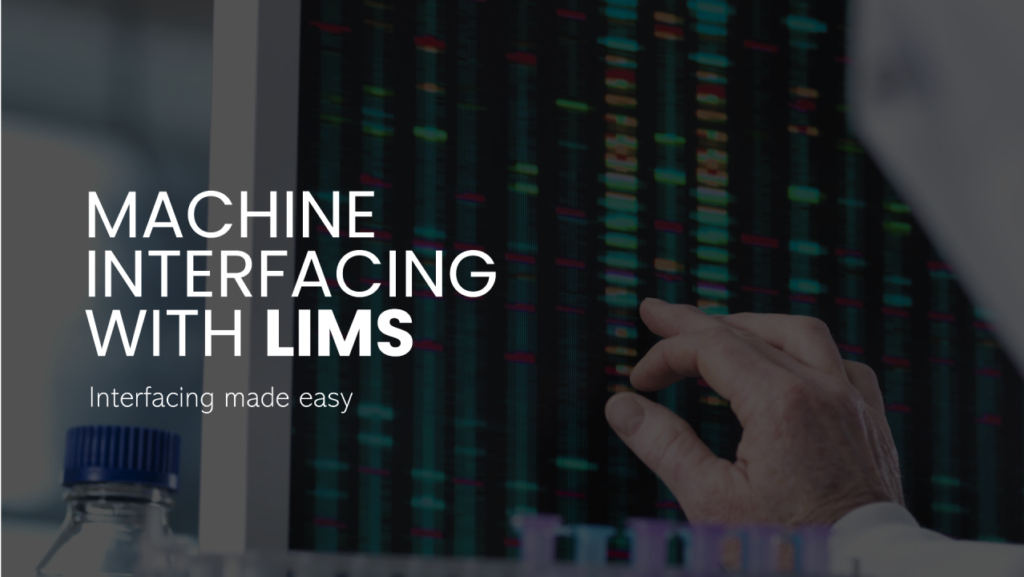
201,Chandravarsha Commercial Complex, Pashan, Pune

Sales:+91 7447789075

Sales:+91 7276004413

sales@elabassist.com

Optimizing Lab Efficiency Through Machine Interfacing with LIMS
January 6, 2025
In today’s fast-paced healthcare environment, laboratory efficiency plays a crucial role in delivering timely, accurate, and high-quality diagnostic results. As labs strive to meet growing demands, Advanced Machine Interfacing for Pathology Labs has become a game-changer, streamlining operations and enhancing productivity. The integration of laboratory instruments with a Laboratory Information Management System (LIMS) allows labs to automate workflows, reduce errors, and optimize overall performance.
But why is Machine Interfacing in LIMS important? Let’s explore the challenges labs face without machine interfacing and the transformative benefits it brings when properly implemented.
The Challenges of Manual Laboratory Processes
Laboratories that still rely on manual processes for handling equipment and managing data are often prone to several challenges:
- Human error: Manual entry of data from lab instruments to the system increases the risk of transcription errors.
- Delays in testing: Without automation, labs experience delays in processing results, causing backlogs and affecting the delivery of reports.
- Inconsistent data: When labs operate without Laboratory Equipment Interfacing, they often deal with incomplete or inaccurate data, leading to misdiagnoses or the need for retesting.
These inefficiencies impact patient care, increase operational costs, and create a bottleneck in lab workflows. Fortunately, Machine Interfacing for Healthcare Laboratories offers a solution.
The Importance of Machine Interfacing in LIMS
Machine interfacing allows seamless communication between laboratory instruments and the LIMS. This automated system enhances data accuracy, reduces turnaround time, and improves overall lab productivity. Let’s break down the key benefits:
- Automating Laboratory Testing Processes: When interfacing instruments with LIMS, data from lab tests are automatically captured and transferred to the system. This eliminates manual data entry, reduces human error, and accelerates test completion.
- Lab Instrument Interface: By integrating each lab device with the LIMS, the system can automatically retrieve data from various sources, including chemistry analyzers, hematology machines, and immunoassay systems, consolidating all results in a unified platform.
- Interfacing the Laboratory Inventory with LIS: One overlooked aspect of machine interfacing is inventory management. By connecting instruments with the LIMS, labs can track reagent and consumable usage, ensuring stock levels are automatically updated based on testing volume, thus preventing stockouts or overstocking.
- Real-time Monitoring and Reporting: With Instrument Interfacing, data from diagnostic machines are instantly recorded in the LIMS, enabling real-time monitoring and immediate report generation for physicians and patients.
- Improved Accuracy and Compliance: Automated interfacing ensures that results are always accurate and traceable, supporting regulatory compliance by maintaining a clear audit trail of every test conducted.
How Machine Interfacing is Transforming Pathology Labs
Advanced Machine Interfacing for Pathology Labs is revolutionizing the field by offering seamless data flow between diagnostic machines and the LIMS. By automating the transfer of information, labs can increase throughput without sacrificing accuracy. Instrument interfacing ensures that lab managers can process more samples in less time while delivering high-quality results, vital for patient care.
One of the biggest advantages of Machine Interfacing in LIMS is its scalability. As new diagnostic technologies emerge, labs can easily integrate these instruments into their existing LIMS, ensuring they stay ahead in the ever-evolving healthcare landscape.
Optimizing Workflow with Machine Interfacing for Healthcare Laboratories
Integrating LIMS with laboratory instruments also helps streamline workflows across various departments. For instance, once a sample is processed, the LIMS can trigger automatic notifications to pathologists, informing them that results are ready for review. This efficient workflow eliminates communication gaps and ensures that critical results are delivered promptly.
Additionally, Laboratory Equipment Interfacing allows labs to centralize all data and make it accessible from a single platform. This centralization is crucial for labs dealing with large volumes of samples or those involved in clinical research where data accuracy is paramount.
The Future of Laboratory Automation with Machine Interfacing
As healthcare laboratories continue to evolve, the demand for fully automated systems will only increase. Automating Laboratory Testing Processes through machine interfacing is just the beginning. Future developments could see even greater integration between LIMS and external systems, from electronic health records (EHR) to hospital management systems, making it easier to share results and improve patient care.
Laboratories that embrace this technology will not only streamline their operations but also improve the quality of care they provide. By reducing the manual workload, labs can focus more on diagnostics and less on administrative tasks.
Conclusion
The shift toward fully automated laboratories is already underway, with Machine Interfacing in LIMS leading the charge. From boosting accuracy and productivity to optimizing workflows and reducing errors, this technology is reshaping the future of healthcare labs.
Whether you’re a small lab or a large pathology center, implementing Advanced Machine Interfacing for Pathology Labs is no longer a luxury—it’s a necessity. By leveraging the benefits of Lab Instrument Interface and Laboratory Equipment Interfacing, you can enhance your lab’s efficiency and ensure you’re prepared for future advancements in diagnostic testing.
This blog serves as a comprehensive guide to understanding the importance of machine interfacing with LIMS and highlights the advantages of adopting this technology. For more information on how to implement machine interfacing in your lab, check out these resources:
- Why Machine Interfacing in LIMS is important
- Interfacing the Laboratory inventory with LIS
- Advanced Machine interfacing for Pathology Labs
This strategic use of machine interfacing will help labs stay competitive in an ever-evolving healthcare landscape.
